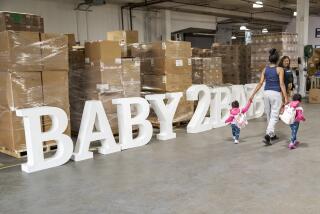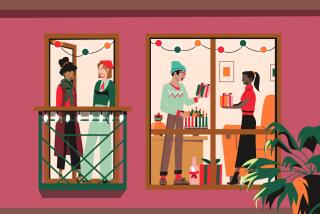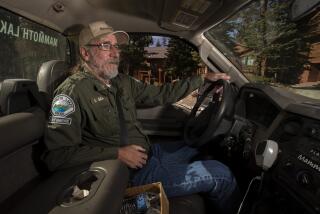Helping Kids in Need Bear Their Burdens
- Share via
Almost 100 years after Theodore Roosevelt’s refusal to shoot a bear cub on a hunting trip inspired a toy maker to name a stuffed bear after him, the teddy bear has become a symbol of the healing power of the American spirit.
Call it bearapy: donating teddy bears to children in need, in the hope that a furry friend will offer some sense of relief, or even solace.
Because of the work of a string of nonprofit institutions, teddy bears arrive daily at America’s cancer wards, homeless shelters and the homes of families confronting various misfortunes.
Lately, they’ve been arriving at the homes of families touched by the Sept. 11 terrorist attacks. Teddy bears have been gathered by schoolchildren wanting to make a difference, businesses hoping to go beyond writing a check, and churches and synagogues looking to do more than bake cookies.
“There’s something magical about a teddy bear,” said Bobbie Moran, who runs Operation Teddy Care with her husband, Bob Baker, a retired trauma psychologist, and their 12-year-old son, C.J., out of their Moss Beach home in Northern California. “They are kind of mythical characters. They don’t have any cultural identity, don’t carry any baggage with them. There’s something about that face that says, ‘I understand; I am listening. If you need a hug, let me give you one.’ ”
Operation Teddy Care began in 1995, when C.J. asked what his family could do for the victims of the Kobe earthquake in Japan. Moran remembered the three teddy bears that she had placed in the family’s earthquake kit when C.J. was younger and suggested sending teddy bears.
The threesome collected bears from friends, neighbors and organizations--just about anyone--until they had amassed 10,000 bears. All went to Japan.
Now, collecting bears for children in “natural and man-made disasters” and distributing them via crisis counselors constitute almost a full-time job for Moran.
Barbara Maurer, who runs the Trauma in Youth Program in Bergen County, N.J., uses Operation Teddy Care bears in counseling children who lost parents in the Sept. 11 attacks.
The gift of a teddy bear, she said, shows them that someone cares. Some children, she said, use the bears as a “transitional object,” something they can talk to until they’re ready to share their feelings with another person.
“I’ve watched children sitting in hospital waiting rooms,” said Irene Matin-Nia, director of the Teddy Bear Care Foundation, “and cry right into their stuffed animals.”
There are more than a dozen teddy bear distribution agencies in the nation, many of them family-run, each with a slightly different focus. TeddyCare in Perris, Calif., places the stuffed animals with service providers, such as police officers, firefighters, trauma centers, ambulances and child welfare offices.
The Teddy Bear Care Foundation in Pleasanton, Calif., focuses on children in pediatric wards. The Teddy Bear Foundation in Ipswich, Mass., donates bears to family shelters and hospitals. Good Bears of the World in Toledo, Ohio, makes teddy bears available to police officers, to keep in the trunks of their squad cars until they are needed. Teddy Bears That Care, in New York, gives its bears to children affected by domestic abuse, illness or the death of a parent.
Reeling off such like-sounding names becomes a bit of a tongue-twister. In another industry, such similarities might be the start of a lawsuit. But not in teddy bear land. Many organizations work closely with one another, in what Moran calls a “teddy bear network.”
“It’s kind of like, whenever people need bears, we can contact one another and ask if they have any to spare,” she said. “It’s one of the nicest networks of humanity you can involve yourself in.”
The groups have adopted relatively standard requirements for the teddy bears they seek. In most cases, the stuffed animals must be new, for health reasons, and less than 15 inches long, to keep down shipping costs. (Most organizations raise money separately to cover the cost of distributing the bears.) Almost all of the groups encourage people to attach a message to the bear so its new owner will know whence it came.
“We get them in all languages,” Moran said. “I think the most touching ones are the ones written by children. They are so sweet and so direct. They write, ‘I know you must be sad, but I will be your friend if you need one.’ ”
Some of the bears are store-bought; others are lovingly handcrafted. But to call them just “stuffed animals” is an affront to some of the bear collectors, who ascribe more importance to their furry friends.
“We don’t call them toys at our house,” said Moran. “We call them counseling assistants or hugs.”
In coming months, all the bears donated to Operation Teddy Care will be sent on to New York, both for children touched by the events of Sept. 11 (those affected directly as well as the children of rescue workers sent to help at the World Trade Center site) and for the New York schools most affected by the Nov. 12 crash of American Airlines Flight 587 into a Queens neighborhood. In the latter effort, Operation Teddy Care is working with the New York-based Hugs Across America.
“Since Sept. 11, it’s been incredible,” Moran said. “As fast as they get here, they are out of here. We still need 10,000 bears, just based on requests we have pending. They would move out of here in no time.”
Here are the Web sites for some of the teddy bear organizations in California:
Operation Teddy Care https://https://teddycare.coastside.net/
TeddyCare https://www.teddycare.net/
Teddy Bear Care Foundation https://www.teddybearcare.com/
More to Read
Sign up for Essential California
The most important California stories and recommendations in your inbox every morning.
You may occasionally receive promotional content from the Los Angeles Times.










